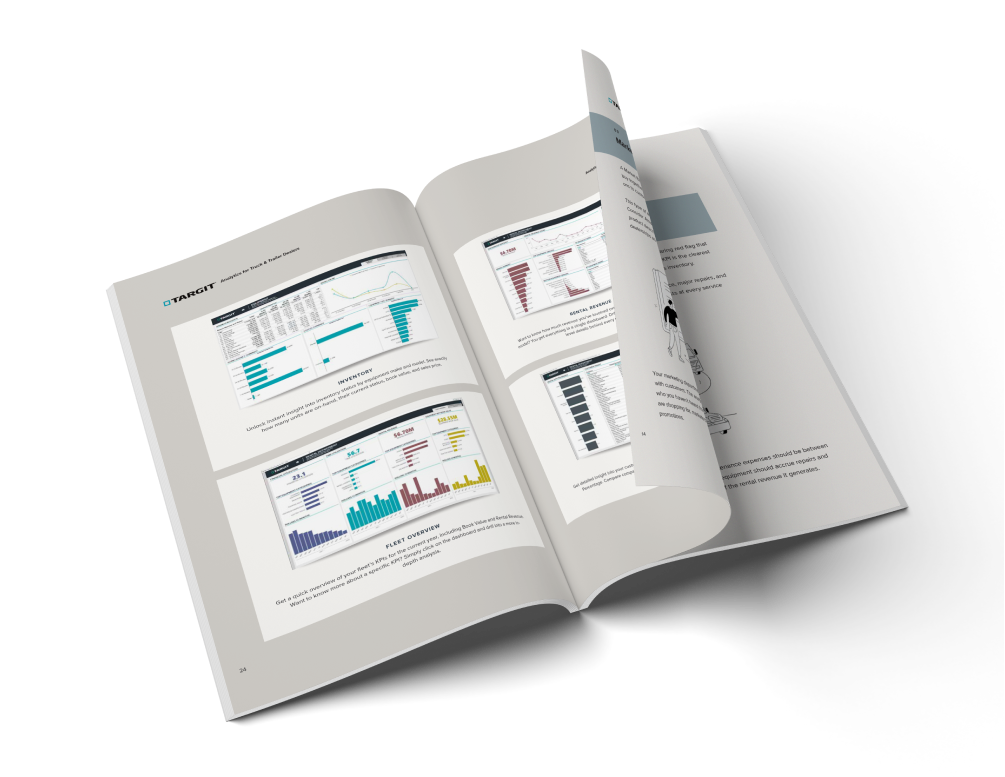Implementing BI Best Practices for Heavy Equipment
The Doggett Equipment Services Group is comprised of seven unique companies under the one brand. To manage this multi-faceted operation with accuracy and efficiency, business leaders like the company's Chief Accounting Officer (CAO) rely on data from a multitude of sources.
But back in 2016, the organization didn’t have a dedicated business intelligence (BI) and reporting solution. This meant employees primarily used their best guesses, static spreadsheets, and other legacy tools to measure performance and inform critical decisions.
Doggett's leadership team knew they needed a full-scale BI solution, but due to the size and complexity of their organization, they decided to implement in phases rather than overhauling reporting across the seven subsidiaries and their c-level operations all at once.
They chose to start with the heavy equipment side of the business, Doggett – John Deere. The dealership’s management system had a few built-in reporting features, but none were robust enough to meet their reporting requirements.
Along with a comprehensive BI platform, Doggett wanted to find a BI vendor that was well-versed in heavy equipment operations and equipped with the expertise to properly configure, expand, and support the dealership’s implementation over time.
TARGIT checked all the boxes through their intuitive, all-in-one BI platform and deep expertise in the heavy equipment space. Plus, TARGIT already had experience with the IntelliDealer dealer management system (DMS), the primary platform Doggett – John Deere used to manage operations.
“A big reason we chose TARGIT was their existing connection to the IntelliDealer DMS and their experience in the heavy equipment industry," say's Dogget's CAO. "They already understood the metrics that mattered most to our business, as well as our unique back-end needs. I also found their platform to be relatively user-friendly compared to BI tools I’ve used in previous roles.”
Doggett – John Deere started their TARGIT journey by configuring new reports for the rental department. These reports were generated automatically and shared with TARGIT users via email, giving them immediate access to the latest performance insights.
Once rental reporting was up and running, Doggett – John Deere set up automated reports for every department in the dealership, including finance, sales, and service. These reports eventually evolved into analytical dashboards as well, which gave executives and department-level managers unparalleled visibility into daily performance, overarching trends, and new opportunities across the business.
Doggett has even created some reports that show how all of the John Deere dealership locations are performing against one another, which drives friendly competition for each store and gives stakeholders updated insights into performance trends by dealership size, territory, and management team.
Managing Multiple Databases With Decision Suite
Dogget's CAO is responsible for the TARGIT project across the entirety of Doggett and in charge of financial reporting in the backend, including end-of-month reports for all seven companies, AR aging reports, and an array of routine accounting tasks. As TARGIT’s in-house project lead, they also spends time assessing various functionality within TARGIT to be sure reports are generating correctly and databases are properly connected.
And when it comes to the technical details of data management and report creation, Doggett’s Business Intelligence Manager is the go-to TARGIT resource. He is in charge of how reports are created and distributed across the organization, and he oversees the multiple databases tied to each of the seven companies.
“Today, TARGIT is in all parts of our business, and it truly offers the balance of security and flexibility we need to manage our operations,” says the company's BI Manager. “We really value TARGIT's ability to connect to multiple data sources while keeping our data secure. Cross-company reporting and integration is also a huge advantage for us.”
Doggett uses TARGIT to automate a significant amount of previously tedious data preparation and reporting tasks that were once managed inside of Excel. This saves the organization a lot of time and effort, while also eliminating formula errors and other potentially hidden issues within various data inputs.
“We took a lot of tasks that were complicated in Excel and streamlined them in TARGIT,” their CAO recalls. “So now, we get to start our work by reviewing reports rather than building them manually. This cuts out wasted time and greatly improves our reporting accuracy in every business area.”
TARGIT is also integral in keeping Doggett’s data clean and up to date. The organization generates various exception reports at the executive and subsidiary levels to identify reporting errors or performance shortfalls before they impact business health.
These reports help Doggett identify and resolve issues quickly rather than finding out months later that a report has been running incorrectly or one area of the business has been significantly underperforming.
Expanding Reporting Across the Doggett Ecosystem
Today, Doggett uses TARGIT in all companies associated with its brand, but each has a different level of BI maturity. The frontrunner is Doggett – John Deere, where TARGIT was first introduced, but the other six have made great strides in implementing BI into their performance management and decision-making processes.
Right now, Doggett's main focus is evolving their Freightliner, Ford, and Toyota subsidiaries by equipping each business with reports and dashboards for finance, sales, service, and rental.
The Vice President of Doggett – Toyota explains the importance of providing managers and department heads with digestible, up-to-date dashboards to manage their forklift business:
“As service managers, it’s easy to get caught up in the details of selling, managing technicians, and driving business. The TARGIT dashboards allow us to focus on the most important numbers behind our operations and monitor them efficiently on a daily basis.”
The Doggett - Toyota team used to rely on people to directly communicate results and insights with one another, which took a lot of time and put a lot of constraints on autonomy. But now, each manager can use analytics to make informed decisions about how they manage and grow their departments.
“We used to distribute one-time reports via email as a reactive measure when a specific number was off. Today, we continuously monitor department-level dashboards. We use them to set daily goals and understand performance throughout the month. TARGIT has become a daily tool we use to manage the business.”
At the start of each day, Doggett – Toyota's VP opens TARGIT dashboards to check utilization, revenue, sales, inventory levels, and work-in-progress orders by department. He also uses the tool to zoom out and evaluate each location’s performance, so he can get ahead of potential issues and gather important context ahead of site visits.
These insights help him and the Branch and Department Managers he works with to proactively address concerns and capitalize on new opportunities immediately, rather than waiting weeks or months for a retrospective report to hit their inboxes.
Making Proactive Decisions at Every Level of Operations
Doggett's CAO explains that, in the early stages of implementation, power users typically emailed reports out to the rest of the business. But over time, they began giving more employees direct access to TARGIT, which streamlined data sharing and improved visibility across multiple business areas.
In the past, corporate leaders used to rely on Controllers from each company to send them reports. Now, they can consume data from all companies directly inside of TARGIT dashboards, and they don’t have to wait until month’s end to see results.
“Thanks to TARGIT, our corporate stakeholders can access powerful insights in just a click." The CAO has also recently added data from Doggett’s payroll system to these dashboards, so leadership has real-time access to turnover rates, retention rates, and other staffing metrics.
In the finance department, accounting teams use TARGIT most heavily around the end of the month. The CAO uses TARGIT’s dynamic interface to easily flip through financial overview for each of Doggett’s seven subsidiaries. Then, she drills down into detailed reports related to invoicing, aging accounts, or liability accounts. These insights allow her to see if there are any issues brewing, so she and the rest of the finance team can get ahead of them before they disrupt cash flow.
The company's BI Manager spends his time in TARGIT a bit differently. He and his team of analysts receive a continuous stream of requests from employees throughout the Doggett business ecosystem, both for new analyses or modifications to exisitng reports and dashboards.
At the start of each day, the BI team goes through the list to prioritize and delegate the requests. Then, they pass the new analyses on to managers for review before sending them out to business users in various parts of the organization.
Beyond his day-to-day report creation tasks, the BI Manager meets with managers and executives every two weeks to discuss priorities for expanding the TARGIT implementation and explore new applications for the solution.
He also spends a lot of time with the employees who use TARGIT in their day-to-day, like service managers and department heads, to learn more about their needs, goals, and pain points related to BI.
“It’s nice to ask people why they need a certain report or follow-up to learn more about their specific requirements. Our end-users are used to legacy tools like Excel, so it’s often about shifting their mindset and showing them what’s possible in TARGIT.”
Looking to the Future of Data Analytics at Doggett
Even though Doggett is already using TARGIT in many business areas, the company's CAO shares that the organization’s goal is to round out reporting in every one of its seven companies.
“We want to continue building dashboards that will drive our businesses forward. And for every unique system we use, we’ll need to spend some time understanding the data and how to organize it.”
Along with understanding and connecting to each system inside Doggett’s business environment, the company's BI Manager would also like to explore the possibility of integrating with partners’ data sources.
"We want to tap into our vendors’ data and bring that into TARGIT, so we can track parts ordered, units ordered, etc. By combining OEM data with our own, we can proactively adjust to changes in our business, resolve issues faster, and improve visibility for both parties.”
The team also wants to find ways to make Doggett’s reports and dashboards even more accessible to the organization’s end-users, specifically via embedded analytics and mobile reports.
“Having TARGIT objects embedded in our own systems would be amazing. It would allow us to instantly access the latest customer information. We also want to get reports more structured so they can be consumed on mobile devices.”


.png?width=1200&height=251&name=e-Emphasys%20Intellidealer%20(1).png)






